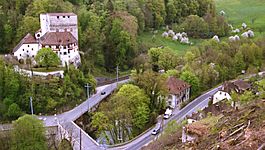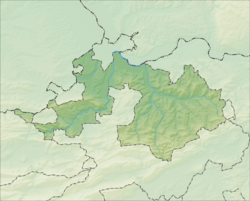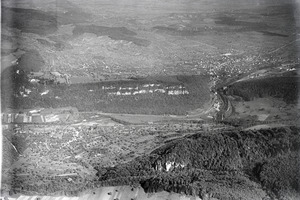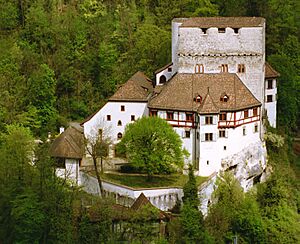Duggingen facts for kids
Quick facts for kids
Duggingen
|
||
|---|---|---|
 |
||
|
||
| Country | Switzerland | |
| Canton | Basel-Landschaft | |
| District | Laufen | |
| Area | ||
| • Total | 5.86 km2 (2.26 sq mi) | |
| Elevation | 339 m (1,112 ft) | |
| Population
(Jun 2021 )
|
||
| • Total | 1,550 | |
| • Density | 264.5/km2 (685.1/sq mi) | |
| Postal code |
4202
|
|
| Surrounded by | Aesch, Dornach (SO), Grellingen, Himmelried (SO), Hochwald (SO), Pfeffingen, Seewen (SO) | |
Duggingen is a small town, also called a municipality, in Switzerland. It is located in the Laufen district within the canton of Basel-Country. It's a great place to learn about Swiss history and nature.
Contents
History of Duggingen
Duggingen was first mentioned a long time ago, around the year 1330. Back then, it was known by a slightly different name: Tuggingen.
Geography of Duggingen
Duggingen covers an area of about 5.87 square kilometers (about 2.27 square miles). A big part of this land, about 57.4%, is covered by forests. About 29% of the land is used for farming. This includes fields for crops and pastures for animals.
The town itself, with its buildings and roads, takes up about 12.8% of the land. A small part, about 1.4%, is made up of rivers. Duggingen is located in the Laufen district. It sits on a flat area above the Birs valley. The town is a linear village, which means its buildings are mostly spread out along a main road.
Duggingen's Coat of Arms
A coat of arms is like a special symbol for a town or family. Duggingen's coat of arms shows a black bear standing up. The bear has red claws, tongue, and other features. It stands on three green hills. This design is on a gold background.
People of Duggingen
Duggingen has a population of 1550 people. Most people in Duggingen speak German. A smaller number of people speak French or Italian language.
Many people who live in Duggingen were also born there. Others moved from different parts of Switzerland or from other countries. The town has a mix of families and single people living in different types of homes. Most homes are single-family houses.
The chart below shows how Duggingen's population has grown over many years:

Important Heritage Sites
Angenstein Castle is a very important historical place in Duggingen. It is listed as a Swiss heritage site of national significance. This means it's a special place that is protected and valued for its history and culture. The entire area around Angenstein Castle is also part of the Inventory of Swiss Heritage Sites.
Economy and Jobs
In Duggingen, people work in different types of jobs.
- Primary sector jobs involve getting raw materials, like farming. About 22 people work in this area.
- Secondary sector jobs involve making things, like in factories or construction. About 249 people work in this area.
- Tertiary sector jobs involve providing services, like in shops, restaurants, or schools. About 135 people work in this area.
Many people who live in Duggingen travel to other towns for work. About 21.4% of workers use public transportation, like trains, to get to their jobs. More than half, about 52.4%, use their own cars.
Religion
Many people in Duggingen are Roman Catholic or belong to the Swiss Reformed Church. There are also people who follow other Christian faiths, Judaism, or Islam. Some people do not belong to any church.
Transportation
Duggingen is connected by train. It sits on the Basel–Biel/Bienne line. You can catch local trains at the Duggingen railway station. This makes it easy for people to travel to and from the town.
Education
Many people in Duggingen have completed their upper secondary education, which is like high school. Some have also gone on to higher education, like university. Students from other towns come to Duggingen for school. Also, some students from Duggingen go to schools in other towns.
See also
 In Spanish: Duggingen para niños
In Spanish: Duggingen para niños






